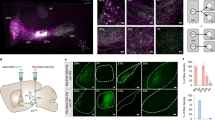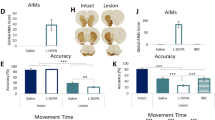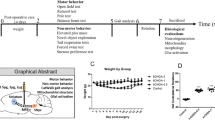Abstract
AT least some of the symptoms of Parkinson's disease are believed to result from the degeneration of nigrostriatal dopaminergic neurones which normally innervate the striatum. Parkinsonian patients have an abnormally low concentration of dopamine in this region of the basal ganglia1,2, and parkinsonian symptoms can be alleviated by the dopamine precursor L-dopa3. A quantitative animal model which has proved useful in assessing the potential therapeutic value of drugs in the treatment of parkinsonism was described some years ago by Ungerstedt and Arbuthnott4. Rats, in which the nigrostriatal pathway has been destroyed unilaterally by 6-hydroxydopamine (6-OHDA), were shown to rotate towards the lesioned side when injected with drugs, such as amphetamine, which release dopamine from neurones in the brain, and towards the unlesioned side when injected with L-dopa and dopamine agonists5,6. This contralateral rotation has been attributed to supersensitivity of the denervated striatal dopamine receptors5,6.
This is a preview of subscription content, access via your institution
Access options
Subscribe to this journal
Receive 51 print issues and online access
$199.00 per year
only $3.90 per issue
Buy this article
- Purchase on Springer Link
- Instant access to full article PDF
Prices may be subject to local taxes which are calculated during checkout
Similar content being viewed by others
References
Ehringer, H., and Hornykiewicz, O., Klin. Wschr., 38, 1236–1239 (1960).
Bernheimer, H., Birkmayer, W., and Hornykiewicz, O., Klin. Wschr., 41, 465–469 (1963).
Cotzias, G. C., van Woert, M. H., and Schiffer, L. M., New Engl. J. Med., 276, 374–379 (1967).
Ungerstedt, U., and Arbuthnott, G. W., Brain Res., 24, 485–493 (1970).
Ungerstedt, U., Acta physiol. scand., Suppl., 367, 69–93 (1971).
Von Voigtlander, P. F., and Moore, K. E., Neuropharmacology, 12, 451–462 (1973).
Ungerstedt, U., Acta physiol. scand., Suppl. 367, 1–48 (1971).
Pijnenburg, A. J. J., Woodruff, G. N., and Van Rossum, J. M., Brain Res., 59, 289–302 (1973).
Pijnenburg, A. J. J., Honig, W. M. M., and Van Rossum, J. M., Psychopharmacologia, 41, 87–95 (1975).
Kelly, P. H., Seviour, P. W., and Iversen, S. D., Brain Res., 94, 507–522 (1975).
Kelly, P. H., Miller, R. J., and Neumeyer, J. L., Eur. J. Pharmac., 35, 85–92 (1976).
Kelly, P. H., and Iversen, L. L., Psychopharmacologia, 45, 221–224 (1975).
Iversen, S. D., and Kelly, P. H., in Chemical Tools in Catecholamine Research, 1 (edit. by Jonsson, G., Malmfors, T., and Sachs, C.), 327–333 (North-Holland-American Elsevier, New York, 1975).
Woodruff, G. N., Kelly, P. H., and Elkhawad, A. O., Psychopharmacology, 41, 195–198 (1976).
Elkhawad, A. O., and Woodruff, G. N., Br. J. Pharmac, 54, 107–114 (1975).
Kelly, P. H., Brain Res., 100, 163–169 (1975).
Pellegrino, L. J., and Cushman, A. J., A Stereotaxic Atlas of the Rat Brain (Appleton-Century-Crofts, New York, 1968).
Glowinski, J., and Iversen, L. L., J. Neurochem., 13, 655–669 (1966).
Horn, A. S., Cuello, A. C., and Miller, R. J., J. Neurochem., 22, 265–270 (1974).
Moore, K. E., and Phillipson, O. T., J. Neurochem., 25, 289–294 (1975).
Cuello, A. C., Hiley, R., and Iversen, L. L., J. Neurochem., 21, 1337–1340 (1973).
Breese, G. R., and Traylor, T. D., Br. J. Pharmac., 42, 88–99 (1971).
Ungerstedt, U., Butcher, L. L., Butcher, S. G., Anden, N-E., and Fuxe, K., Brain Res., 14, 461–471 (1969).
Fuxe, K., et al., J. Pharmac., (Paris), 6, 117–129 (1975).
Powell, E. W., and Leman, R. B., Brain Res., 105, 389–403 (1976).
Rioch, D. M., J. comp. Neurol., 53, 319–388 (1931).
Smith, O. C., J. comp. Neurol., 51, 65–127 (1930).
Author information
Authors and Affiliations
Rights and permissions
About this article
Cite this article
KELLY, P., MOORE, K. Mesolimbic dopaminergic neurones in the rotational model of nigrostriatal function. Nature 263, 695–696 (1976). https://doi.org/10.1038/263695a0
Received:
Accepted:
Published:
Issue Date:
DOI: https://doi.org/10.1038/263695a0
This article is cited by
-
What does dopamine mean?
Nature Neuroscience (2018)
-
Generative rules of Drosophila locomotor behavior as a candidate homology across phyla
Scientific Reports (2016)
-
Modulation of Locomotor Activation by the Rostromedial Tegmental Nucleus
Neuropsychopharmacology (2015)
-
Control of the Nigrostriatal Dopamine Neuron Activity and Motor Function by the Tail of the Ventral Tegmental Area
Neuropsychopharmacology (2014)
Comments
By submitting a comment you agree to abide by our Terms and Community Guidelines. If you find something abusive or that does not comply with our terms or guidelines please flag it as inappropriate.



